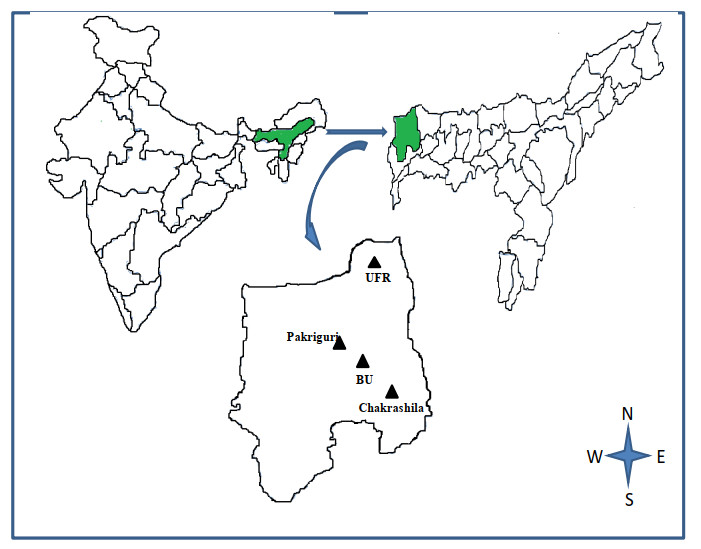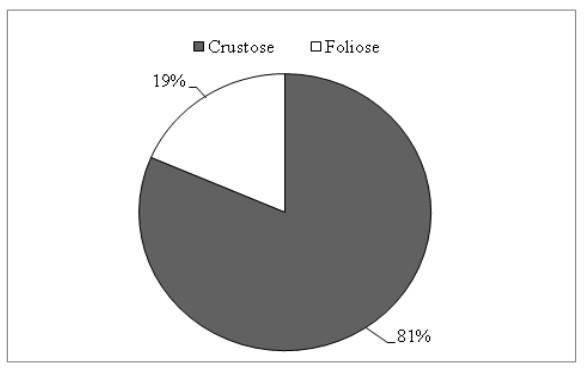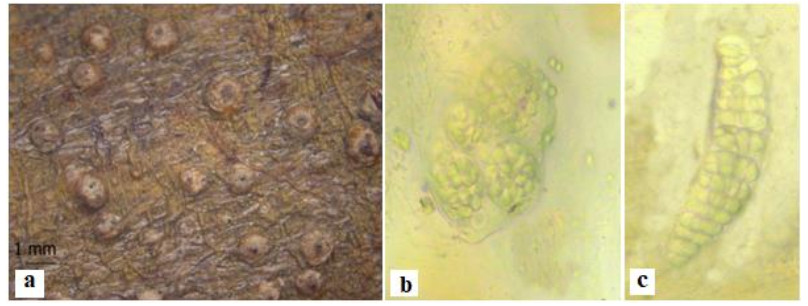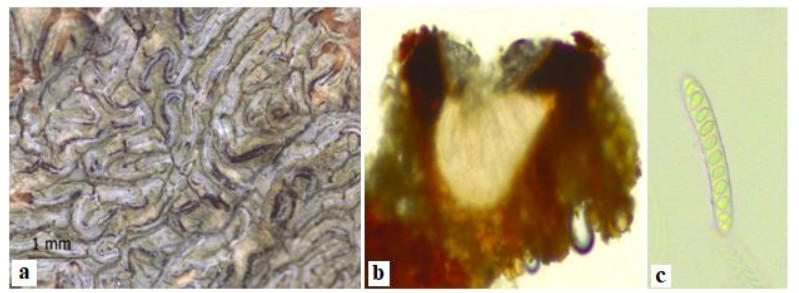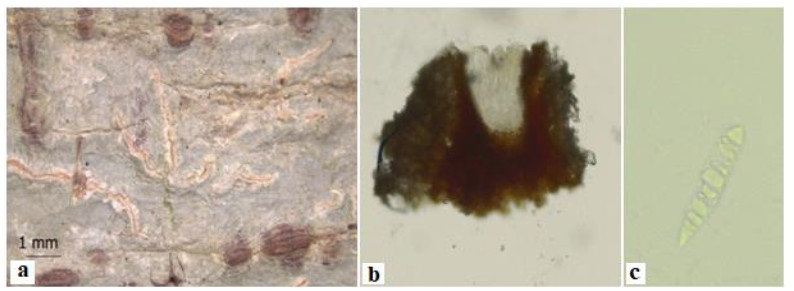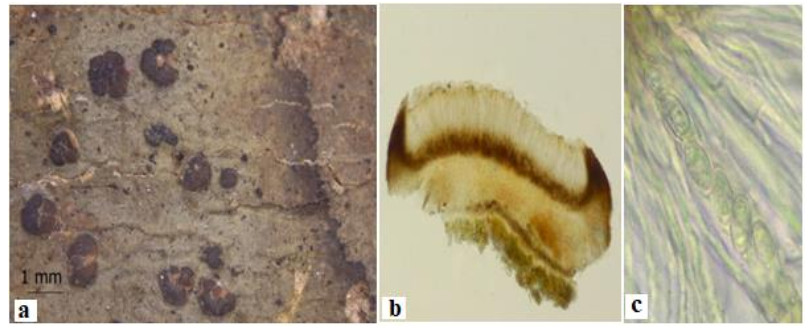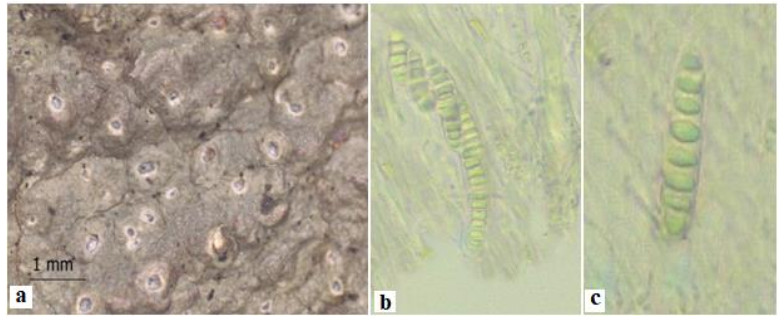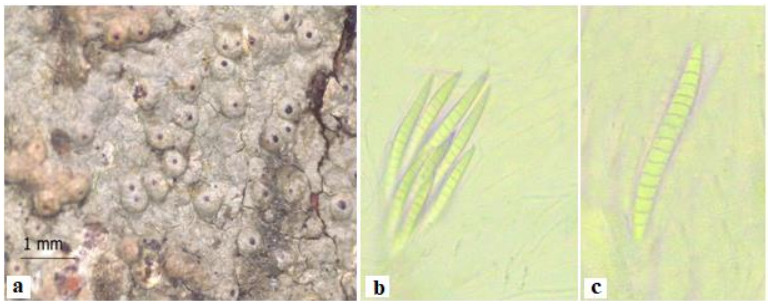HTML
-
About 25, 000 species of lichens have been reported globally (Soundararajan et al. 2019), of which more than 2902 lichens have been reported from India (Sinha & Ram 2020). The eastern Himalaya is one of the richest lichenogeographical regions of India. Singh et al. (2018) reported 1047 species, one sub-species and four varieties. Most of the species are crustose (592 species) and 321 are foliose, 125 are fructicose, nine are squamulose under 212 genera and 63 families. Lichens are a symbiotic association of two organisms viz. an alga and a fungus, and are one of the most widely distributed organisms. Recently with the discovery of about 1050 secondary metabolites (Stocker-Wörgötter 2008), its applications as potential antimicrobial, antioxidant, anticancer activity (Zambare & Christopher 2012, Shivanna & Garampalli 2014, 2016, Kekuda et al. 2017) are gaining much elevation.
Being a biodiversity hotspot, Assam has always been a region of attraction. It is rich in floral as well as faunal diversity and it comes under the northeastern Indian biogeographic zone. The region is suitable for the colonization of diverse organisms including lichen. In spite of being rich in biodiversity, the exploratory work on lichens of Assam is limited. The study of lichen in Assam was first initiated by Scottish lichenologist Stirton (1881) followed by Santesson 1952, Awasthi & Singh 1973. Later on, the lichenological work was extended by Pant & Upreti 1993, Rout et al. 2005, 2010, Gupta & Sinha 2011, 2016, Sinha et al. 2013, Daimari et al. 2014. Recently, Gupta & Sinha (2018) reported 300 species of lichens from various parts of Assam of which eight lichen species have been reported from Kokrajhar district for the first time. However, greater portion of the district remain unexplored. Therefore, the present study was taken up with an aim to explore and enumerate the lichen diversity of Kokrajhar district.
Kokrajhar, one of the 34 districts of Assam state is the gateway to the northeastern part of India. The district is located in the foothills of Bhutan on its northern side and lies between 26°18'–26°54' N latitude and 89°46'–90°58' E longitude. It has an average elevation of 38 m and enjoys sub-tropical monsoon climate with high levels of humidity (ca 85%) and heavy rainfall (3139 mm). Majority of the land is covered by agricultural fields. Forest is one of the most prominent features of Kokrajhar district. The forest cover is mainly confined to the northern part of the district along the foothills of Bhutan. Presence of the foothill makes the region ecologically interesting with varied climate, edaphic and altitudinal gradients.
-
Four sites viz. Bodoland University Campus (BU), Chakrashila Wildlife Sanctuary, Pakriguri (residential area) and Ultapani Forest Range (UFR) were selected for the present study, within Kokrajhar district (Fig. 1). The vegetation of Ultapani in particular is very interesting with dense vegetation that includes semi-evergreen and moist deciduous forest and also houses various species of orchids. During the month of March and April the forest looks exceptionally beautiful as innumerable butterflies flourish it and so is also called 'Haven of Butterfly'. Chakrashila Wildlife sanctuary on the other hand is mostly dominated by Shorea robusta and is famous for golden langur.
Collection and identification of samples
-
Lichen samples were collected during the year 2017 and 2018 from the bark of trees. Samples were then air dried and sorted. Identification of the lichen specimens were done morphologically, anatomically and chemically. Morphological characters were examined using stereo zoom microscope (Leica EZ4W) and anatomical details of the thallus and fruiting bodies were studied in free hand section using water as mounting medium under compound microscope (Leica DM750). Chemical spot test was performed using K, C, KC, P reagents (Nayaka 2014). TLC was carried out to identify the lichen substances using standard solvent system, Toluene (180): 1, 4- Dioxane (60): Acetic acid (8) (Orange et al. 2001). Recent literatures (Awasthi 1991, 2007, Lücking et al. 2009, Aptroot 2012, Aptroot & Lücking 2016, Gupta et al. 2016, Joshi et al. 2018) were referred for identification of the lichen species. The specimens are deposited in the Department of Botany, Bodoland University (BU) Kokrajhar, Assam. The faces of fungi numbers were registered as described in Jayasiri et al. (2015).
Sampling sites
-
From the present study, 54 species of lichens belonging to 21 genera and 14 families are reported (Table 1). Majority of the species are crustose (44 species) and 10 foliose (Fig. 2). Graphidaceae is the dominant family with five genera and 26 species followed by Porinaceae and Caliciaceae with 5 species each. Dirinaria consimilis is frequently found in all the four sites showing its wide distribution.
Table 1. List of lichen species with their growth form, family and distribution in the study sites
Sl.no. Name of species GF Family Study sites 1 2 3 4 1 Anthracothecium macrosporum (Hepp) Müll. Arg. C Pyrenulaceae - + - - 2 Arthonia dispersula Nyl. C Arthoniaceae + - - - 3 A. tumidula (Ach.) Ach. C Arthoniaceae + - + - 4 Astrothelium alboverrucoides Aptroot C Trypetheliaceae - + - - 5 Bacidia medialis (Tuck.) Zahlbr. C Bacidiaceae + - - - 6 Diorygma hieroglyphicum (Pers.) Staiger & Kalb C Graphidaceae + - - - 7 Dirinaria aegialita (Afzel. ex Ach.) B.J. Moore F Caliciaceae + + + - 8 D. applanata (Fée) D.D. Awasthi F Caliciaceae - - - + 9 D. consimilis (Stirt.) D.D. Awasthi F Caliciaceae + + + + 10 Graphis alboglaucescens Adaw. & Makhija C Graphidaceae - + - - 11 G. alpestris (Zahlbr.) Staiger C Graphidaceae + - - - 12 G. arecae Vain. C Graphidaceae - - - + 13 @G. capillacea Stirt. C Graphidaceae - - - + 14 @G. chlorotica A. Massal. C Graphidaceae + - - - 15 G. crebra Vain. C Graphidaceae - - - + 16 G. dendrogramma Nyl. C Graphidaceae - - - + 17 @G. distincta Makhija & Adaw. C Graphidaceae + - - - 18 G. elegantula Zahlbr. C Graphidaceae + - - - 19 G. epimelaena Müll. Arg. C Graphidaceae + - - - 20 G. glaucescens Fée C Graphidaceae - - - + 21 @G. intermediella Stirt. C Graphidaceae - - - + 22 G. pinicola Zahlbr. C Graphidaceae + - - - 23 G. pyrrhocheiloides Zahlbr. C Graphidaceae - - - + 24 G. renschiana (Müll. Arg.) Stizenb. C Graphidaceae - + - - 25 G. sayeri Müll. Arg. C Graphidaceae - - - + 26 G. scripta (L.) Ach. C Graphidaceae - + - - 27 @G. subasahinae Nagarkar & Patw. C Graphidaceae - + - - 28 G. sundarbanensis Jagad.Ram & G.P. Sinha C Graphidaceae - - - + 29 G. xanthospora Müll. Arg. C Graphidaceae - - - + 30 @Hemithecium croceum Makhija & Adaw. C Graphidaceae - + + - 31 Herpothallon philippinum (Vain.) Aptroot & Lücking C Arthoniaceae - - + - 32 Heterodermia diademata (Taylor) D.D. Awasthi F Physciaceae - + + - 33 H. speciosa (Wulfen) Trevis. F Physciaceae - + - - 34 Lecanora tropica Zahlbr. C Lecanoraceae - - + - 35 Letrouitia domingensis (Pers.) Hafellner & Bellem. C Letrouitiaceae + - - - 36 Malmidea piperis (Spreng.) Kalb, Rivas Plata & Lumbsch C Malmideaceae - - + - 37 Ocellularia allosporoides (Nyl.) Patw. & Kulk. C Thelotremataceae - + + - 38 Parmotrema saccatilobum (Taylor) Hale F Parmeliaceae - - - + 39 P. tinctorum (Despr. ex Nyl.) Hale F Parmeliaceae - + + - 40 P. tsavoense (Krog & Swinscow) Krog & Swinscow F Parmeliaceae - - + - 41 Pertusaria quassiae (Fée) Nyl. C Pertusariaceae - - + - 42 @Phaeographis extrusula (Stirt.) Zahlbr. C Graphidaceae + - - - 43 @P. submarcescens (Leight.) Zahlbr. C Graphidaceae + - - - 44 Porina belanospora (Nyl.) Müll. Arg. C Porinaceae + - - + 45 P. interestes (Nyl.) Harm. C Porinaceae - - - + 46 P. internigrans (Nyl.) Müll. Arg. C Porinaceae - + - - 47 P. mastoidea Fée C Porinaceae - + + - 48 @P. subhibernica Upreti C Porinaceae + - - - 49 Pyrenula macrospora (Degel.) Coppins & P. James C Pyrenulaceae + - - - 50 P. subelliptica (Tuck.) R.C. Harris C Pyrenulaceae + - - - 51 Pyxine cocoes (Sw.) Nyl. F Caliciaceae - - - + 52 P. reticulata (Vain.) Vain. F Caliciaceae - - - + 53 Sarcographa glyphiza (Nyl.) Kr.P. Singh & G.P Sinha C Graphidaceae - - + - 54 S. labyrinthica (Ach.) Müll. Arg. C Graphidaceae - - + - Note: GF = Growth form, C = Crustose, F = Foliose, "-" = Absent, "+" = Present
Study sites: 1. Chakrashila Wildlife Sanctuary, 2. Ultapani Forest Range, 3. Bodoland University Campus,
4. Pakriguri, Residential area; @Endemic to India
-
Astrothelium alboverrucoides Aptroot, Lichenologist 48(6): 611, 2016 Fig. 3 Index Fungorum number: IF815207; Faces of fungi number: FoF10256
Thallus crustose, corticolous, corticate, smooth somewhat shiny, continuous, yellowish to olivaceous. Ascomata globose, mostly single, with often constricted base. Ostiole apical, not fused, pointed, ochraceous to brown. Hymenium inspersed with oil globules. Asci 4-spored, ascospores hyaline, muriform, ellipsoid, 122–131 x 27–29 µm.
Chemistry - not defined but light grey spot at Rf Class 4.
Ecology - The species is found growing on the bark of a tree in Ultapani Forest Range.
Distribution - Indonesia.
Species examined - INDIA: Assam, Kokrajhar district, Ultapani Forest Range, on the bark of a tree, 23/02/2017, S. Basumatary, P. Islary & R. Daimari, 2017-0033, Department of Botany, (BU) Kokrajhar, Assam.
Comment - New record to India.
Graphis sayeri Müll. Arg., Flora (Regensburg) 70(25): 401, 1887 Fig. 4
Thallus crustose, corticolous, corticated, disc concealed, lirellae variable, labia white pruinose, immersed to erumpent with apically thin thalline margin, elongate and irregularly branched (caesiella-morph). Labia entire, excipulum apically carbonised, hymenium clear. Ascospores hyaline, transversely 6–9 septate, 36–40 x 6–7 µm.
Chemistry - No lichen substances detected by TLC.
Ecology - The species is found growing on the bark of Ficus hispida in a residential area.
Distribution - India (Uttarakhand), Australia, Pantropical.
Species examined - INDIA: Assam, Kokrajhar district, Pakriguri, on Ficus hispida, 04/07/2018, P. Islary & S. Brahma, 2018-0065, Department of Botany, (BU) Kokrajhar, Assam.
Comment - New record to Assam
Hemithecium croceum Makhija & Adaw., Mycotaxon 91: 348, 2005 Fig. 5
Thallus crustose, corticolous, greenish with white tinge to greyish green, rough, cracked, delimited by a thin black hypothallus. Ascomata lirelline, simple to irregularly branched, scattered, immersed to semi-emergent, acute to obtuse ends, disc narrow, slit like, orange red, epruinose. Exciple present below, entire, non-carbonized, yellowish to woody brown, laterally convergent, covered by a thalline exciple till top. Hymenium hyaline, clear, I-, epithecium thin, brown, K-, paraphysis simple, long, thick, unbranched. Asci 6-spored, ascospores hyaline, transversely 8–9 septate, ellipsoidal, 30–49 x 4–6 µm, I+ blue.
Chemistry - Stictic acid, cryptostictic and constictic acid.
Ecology - The species is found growing on the bark of a tree in the University campus and on the bark of Bombax sp. in Ultapani Forest Range.
Distribution - India (Andaman and Nicobar Island).
Species examined - INDIA: Assam, Kokrajhar district, Ultapani Forest Range, on Bombax sp., 23/02/2017, S. Basumatary, P. Islary & R. Daimari, 2017-0023, BUH and on the bark of a tree, 12/04/2018, J. P. Goswami, 2018-0047, Department of Botany, (BU) Kokrajhar, Assam.
Comment - New record to Assam and endemic to India.
Malmidea piperis (Spreng.) Kalb, Rivas Plata & Lumbsch, Bibliotheca Lichenologica 106: 165, 2011 Fig. 6
Thallus crustose, corticolous, greenish grey, smooth, apothecia without thalline excipulum, margin lacking medullary layer, medulla K+ orange, hypothecium dark brown to brown black. Asci 8-spored, ascospores hyaline, simple, 13–14 x 5–6 µm.
Chemistry - No lichen substances detected by TLC.
Ecology - The species is found growing on the bark of Lannea coromandelica (Houtt.) Merr. in the University Campus.
Distribution - India (Sikkim), Netherland.
Species examined - INDIA: Assam, Kokrajhar district, Bodoland University Campus, on Lannea coromandelica (Houtt.) Merr. 05/04/2018, J. P. Goswami & R. Daimari, 2018-0043, Department of Botany, (BU) Kokrajhar, Assam.
Comment - New record to Assam.
Ocellularia allosporoides (Nyl.) Patw. & Kulk. Kavaka 5:5, 1977 Fig. 7
Thallus crustose, corticolous, corticate, endophloeodal to epiphloeodal, dark green, glossy, smooth, continuous to verruculose, mainly non-rimose. Ascomata conspicuous, disc with columella visible from above. Hymenium not inspersed, epihymenium hyaline, with greyish or brownish granules. Collumellar structures well developed in mature ascomata, entire, rarely complex, usually brown to slightly carbonised, rarely strongly carbonised, usually covered with a thick layer of greyish granules. Asci 6-spored, ascospores hyaline, transversely 6–8 septate, amyloid, 50–120 x 10–18 µm.
Chemistry - Stictic acid.
Ecology - The species is found growing on the bark of a tree in Ultapani Forest Rangeand the University campus.
Distribution - India (Arunachal Pradesh, Kerala, Andaman and Nicobar Island, Western Ghats, Eastern Himalaya, Karnataka, Meghalaya), Thailand.
Species examined - INDIA: Assam, Kokrajhar district, Ultapani Forest Range on bark of a tree, 23/02/2017, S. Basumatary, P. Islary & R. Daimari, 2017-0032, Bodoland University campus on the bark of a tree, 26/02/2018, J. P. Goswami, 2018-0036, Department of Botany, (BU) Kokrajhar, Assam.
Comment- New record to Assam
Porina belanospora (Nyl.) Müll. Arg., Bot. Jahrb. Syst. 6: 400, 1885 Fig. 8
Thallus crustose, corticolous, smooth, greyish green, glossy, indeterminate, ecorticate. Ascomata concolorous, minute, immersed to slightly emergent, 0.2–0.3 mm in diam., not constricted at the base. Ostiole pale brown, depressed, ostiolar rim light brown to mostly black. Involucrellum brown, exciple pale yellowish-orange, hymenium studded with crystals. Asci 8-spored, ascospores hyaline, transversely 11–15 septate, 63–67 x 4.9–5.6 µm.
Chemistry - No lichen substances detected by TLC.
Ecology - The species is found growing on the bark of a tree in a wildlife sanctuary and on the bark of Artocarpus heterophyllus Lam., in a residential area.
Distribution - India (Andaman and Nicobar Island, Arunachal Pradesh, Maharashtra, Karnataka, Kerala, Meghalaya, West Bengal), New Zealand, Colombia.
Species examined - INDIA: Assam, Kokrajhar district, Chakrashila wildlife sanctuary, on the bark of a tree, 17/02/2017, P. Islary & S. Basumatary, Pakriguri, on Artocarpus heterophyllus Lam., 02/07/2018, P. Islary & S. Brahma, 2018-0054, Department of Botany, (BU) Kokrajhar, Assam.
Comment - New record to Assam.
-
The species Astrothelium alboverrucoides is new to India. Only few species of Astrothelium are recorded from India (Singh & Sinha 2010, Singh et al. 2015, Niranjan & Sarma 2018). Gupta & Sinha (2018) recorded A. eustomum from Assam, previously observed by Stirton in 1881. Five of the species are new additions to the lichen flora of Assam viz. Graphis sayeri, Hemithecium croceum, Malmidea piperis, Ocellularia allosporoides and Porina belanospora. Nine of the species viz. Graphis capillacea, G. chlorotica, G. distincta, G. intermediella, G. subasahinae, Hemithecium croceum, Phaeographis extrusula, P. submarcescens and Porina subhibernica are endemic to India. Species frequently found or having wide distribution are generally preferred for other lichen related studies such as air quality monitoring. Therefore, Dirinaria consimilis, may be employed for such studies in near future.
Literature survey reveals that lichenological work in the region inspite of its biodiversity hotspot is a farcry. The geographical location and climatic conditions of the region is ideal for the colonization of different groups of lichens and seasonal variation influences the visibility, texture, contrast of colours and appearance of fruiting bodies of lichens in all study sites.
-
Sporadic collection of lichens from these four sites reveal occurrence of 54 species with one new record from India and five to Assam. This indicates that there are wider scopes of finding more new and interesting species of lichens especially in the northern part of the district. Based on the availability of species they can be used for carrying out other lichenological researches such as pollution monitoring studies in the region. From the present study we can conclude that the climatic condition of the region is moderate for lichen growth and it is obvious that extensive exploration of the region for lichens may further produce much more interesting findings and more additions to the lichen flora of India. It will provide baseline information of floristic data regarding the lichen flora of Assam, particularly of the region studied.
- The authors are grateful to the Director CSIR-NBRI, Lucknow for permitting two of the authors (PI & SB) to visit the institute and for providing infrastructure facilities, to Dr. D.K. Upreti for his continuous support and encouragement, authorities of Departments of Botany and Biotechnology, Bodoland University, Kokrajhar, Assam for providing laboratory facilities and various supports related to the present study.
- Copyright: © 2021 by the author(s). This article is an open access article distributed under Creative Commons Attribution License (CC BY 4.0), visit https://creativecommons.org/licenses/by/4.0/.
| R Daimari, P Islary, S Brahma, S Basumatary, JP Goswami, S Nayaka, S Joseph. 2021. Additions to the lichen flora of Assam with special reference to Astrothelium alboverrucoides, a new record to India. Studies in Fungi 6(1):342−351 doi: 10.5943/sif/6/1/25 |












